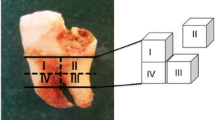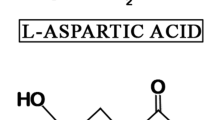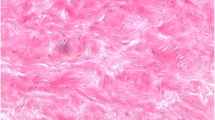Abstract
Determination of age at death on the basis of aspartic acid racemization in dentin is one of the most reproducible and accurate methods. In Germany, age estimation by this method has so far generally not been applied to living persons, since the extraction of a tooth exclusively for age estimation when it is not medically indicated is regarded as ethically and legally problematic. The development of a biopsy technique applicable to dentin took place against this background. Testing the technique and analysis of dentinal biopsy specimens revealed that the biopsy technique is a low-risk procedure that causes only minor discomfort to the affected person. It is readily practicable and facilitates standardized specimen removal. The relationship between the extent of aspartic acid racemization in dentinal biopsy specimens and age is very close, facilitating age estimation. A prerequisite for accurate results is the performance of biopsies under strictly standardized conditions. If this is guaranteed, age determination on the basis of aspartic acid racemization in dentinal biopsy specimens appears to be superior in precision to most other methods in living persons and can be used for all age groups.
Similar content being viewed by others
References
Brunauer LS, Clarke S (1986) Age-dependent accumulation of protein residues which can be hydrolyzed to D-aspartic acid in human erythrocytes. J Biol Chem 261:12538–12543
Clarke S (1987) Propensity for spontaneous succinimide formation from aspartyl and asparaginyl residues in cellular proteins. Int J Pept Protein Res 30:808–821
Dalitz GD (1962) Age determination of adult human remains by teeth examination. J Forensic Sci 3:11
Drusini AG (1993) Age estimation from teeth using soft X-ray findings. Anthropol Anz 51:41–46
Endris R (1979) Praktische forensische Odonto-Stomatologie. Das Gebiß als Indiz und Tatwerkzeug. Kriminalistik, Heidelberg, pp 77–102
Gustafson G (1950) Age determination on teeth. J Am Dent Assoc 41:45–54
Gustafson G (1955) Altersbestimmung an Zähnen. Dtsch Zahndrztl Z 10:1763–1768
Helfman PM, Bada JL (1976) Aspartic acid racemization in dentine as a measure of ageing. Nature 262:279–281
Helfman PM, Bada JL, Shou M-Y (1977) Considerations on the role of aspartic acid racemization in the aging process. Gerontology 23:419–425
Hongwei S (1989) The estimation of tooth age from attrition of the occlusal surface. Med Sci Law 29:69–73
Hongwei S, Jingtao J, Cameron JM (1991) Age determination of the molars. Med Sci Law 31:65–68
Kambe T, Yonemitsu K, Kibayashi K, Tsunenari S (1991) Application of a computer assisted image analyzer to the assessment of area and number of sites of dental attrition and its use for age estimation. Forensic Sci Int 50:97–109
Köhler S, Schmelzle R, Loitz C, Püschel K (1994) Die Entwicklung des Weisheitszahnes als Kriterium der Lebensaltersbestimmung. Ann Anat 176:339–345
Levine RS (1971) The distribution of hydroxyproline in sound human coronal dentine. Arch Oral Biol 16:473–478
Lowenson J, Clarke S (1988) Does the chemical instability of aspartyl and asparaginyl residues in proteins contribute to erythrocyte aging? Blood Cells 14:103–117
Masters PM (1983) Stereochemically altered noncollagenous protein from human dentin. Calcif Tissue Int 35:43–47
Masters PM (1985) In vivo decomposition of phosphoserine and serine in noncollagenous protein from human dentin. Calcif Tissue Int 37: 236–241
Mincer HH, Harris EF, Berryman HE (1993) The A.B.F.O. study of third molar development and its use as an estimator of chronological age. J Forensic Sci 38:379–390
Mörnstad H, Staaf V, Welander U (1994) Age estimation with the aid of tooth development: a new method based on objective measurements. Scand J Dent Res 102:137–143
Ogino T, Ogino H, Nagy B (1985) Application of aspartic acid racemization to forensic odontology: postmortem designation of age of death. Forensic Sci Int 29:259–267
Ohtani S (1994) Age estimation by aspartic acid racemization in dentin of deciduous teeth. Forensic Sci Int 68: 77–82
Ohtani S, Yamamoto K (1987) Age estimation using the racemization of aspartic acid in human dentin. 41:181–190
Ohtani S, Yamamoto K (1990) Estimating age through the amino acid racemization of acid-soluble dentinal peptides. Nippon Hoigaku Zasshi 44:342–345
Ohtani S, Yamamoto K (1991) Age estimation using the racemization of amino acid in human dentin. J Forensic Sci 36:792–800
Ohtani S, Yamamoto K (1992) Estimation of age from a tooth by means of racemization of an amino acid, especially aspartic acid - comparison of enamel and dentin. J Forensic Sci 37:1061–1067
Ritz S, Schütz H-W Schwarzer B (1990) The extent of aspartic acid racemization in dentin: a possible method for a more accurate determination of age at death? Z Rechtsmed 103:457–462
Ritz S, Schütz H-W, Peper C (1993) Postmortem estimation of age at death based on aspartic acid racemization in dentin: its applicability for root dentin. Int J Legal Med 105:289–293
Rutsatz K, Sobkowiak E-M, Bienengräber V, Held M (1985) Feingewebliche Veränderungen des Pulpa-Dentin-Systems nach Präparationstrauma und Applikation von Phosphatzement. Zahn Mund Kieferheilkd 73:123–131
Schumacher G-H, Schmidt H (1976) Anatomie and Biologie der Zähne, 2nd edn Fischer, Stuttgart, pp 344–355
Smith GG, Williams KM, Wonnacott DM (1978) Factors affecting the rate of racemization of amino acids and their significance to geochronology. J Org Chem 43:1–5
Staaf V, Mörnstad H, Welander U (1991) Age estimation based on tooth development: a test of reliability and validity. Scand J Dent Res 99:281–286
Stephenson RC, Clarke S (1989) Succinimide formation from aspartyl and asparaginyl peptides as a model for the spontaneous degradation of proteins. J Biol Chem 264:6164–6170
Xiaohu X, Philipsen HP, Jablonski NG, Pang KM, Jiazhen Z (1992) Age estimation from the structure of adult human teeth: review of the literature. Forensic Sci Int 54: 23–28
Author information
Authors and Affiliations
Rights and permissions
About this article
Cite this article
Ritz, S., Stock, R., Schütz, H.W. et al. Age estimation in biopsy specimens of dentin. Int J Leg Med 108, 135–139 (1995). https://doi.org/10.1007/BF01844824
Received:
Revised:
Issue Date:
DOI: https://doi.org/10.1007/BF01844824




